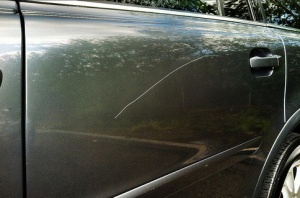Proper maintenance of a car's exterior not only helps it retain its value, but improve its aesthetics as well. Not many of us have had the privilege of owning our cars their whole life and been able to do the maintenance we see fit. Most of us will buy a car from someone we have no history with noticing the defects, may it be swirls, minor scratches, scuffs, or oxidation in the hopes of being able to eliminate them.
Compounding
 The majority of blemishes won’t get past clearcoat. Clearcoat protects the base color coat from UV damage as well as environmental damage. Blemishes that do not break the clearcoat will appear white. These blemishes can be taken care of with polishing compound or a rubbing compound. (Polishing compound is less abrasive than rubbing compound.) Use a terry cloth applicator pad with moderate pressure and a quarter size amount of compound per square foot of body panel. Be sure that the area is clean of debris before using a polishing or rubbing compound otherwise whatever is on the surface of the car will scratch the clearcoat. Wipe away excess compound with a clean cotton terry cloth. Repeat until you achieve desired results.
The majority of blemishes won’t get past clearcoat. Clearcoat protects the base color coat from UV damage as well as environmental damage. Blemishes that do not break the clearcoat will appear white. These blemishes can be taken care of with polishing compound or a rubbing compound. (Polishing compound is less abrasive than rubbing compound.) Use a terry cloth applicator pad with moderate pressure and a quarter size amount of compound per square foot of body panel. Be sure that the area is clean of debris before using a polishing or rubbing compound otherwise whatever is on the surface of the car will scratch the clearcoat. Wipe away excess compound with a clean cotton terry cloth. Repeat until you achieve desired results.
Wet Sanding
If it's a deep scratch but still hasn’t broken through the clearcoat, light wet sanding is a good option. Again, be sure the panel is clean before sanding. When sanding, you’re actually cutting down the level of clear coat in that area until everything smooths out and is below the lip of the scratch. If you’re afraid of sanding too deep, fill the scratch in with a contrasting color touch-up that can be easily removed. Black shoe polish works, or white if you have a dark colored paint. Simply sand until the remaining contrast material has disappeared.
Sanding a car requires a very fine 2000-3000 grit wet/dry sanding paper. Using a rubber or wooden sanding block, dip the paper in a bowl of cold water and begin sanding, using minimal pressure. Do short light strokes along the length of the scratch, making frequent stops to rinse the paper in the water. If you do break through the clear coat while removing the scratch you will have to spray new clear coat on that panel. Similarly if your scratch breaks down to your primer, you’ll have to color match, re-spray the paint coat and the clear coat. The key is to work slowly and lightly till the contrast material is gone.
Buffing after sanding
When the contrast material is gone, dry the area thoroughly and look for any signs of a scratch. When the scratch is confirmed gone, buff the area with rubbing compound. Buffing in a circular motion rubbing compound will lift the haze. Using a power buffer works fast, but for working in small areas a terry cloth and some compound will work great. When all the sandpaper marks are gone remove the rest of the compound with a soft cloth. Using a polishing compound buff the area to remove any imperfections, once the polishing is done use wax or a bonding paint sealant.
Typically, most swirls and scuffs can be removed with a combo attack of rubbing and polishing compounds. And if you’re too nervous to attempt fixing a blemish, take your car to an auto paint or detailing shop to see if they will check it out. If you're confident enough and patient, there is no reason you can't repair the damage yourself and save a few bucks.
About the Author: Tony Robinett
Tony lives in Spokane, Washington and is a 3-D Design Engineer, machinist, and welder. When he's not at work he is designing and fabricating parts for his M3, and other BMW's alike.










